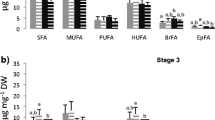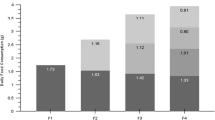Abstract
Effects of maternal food environment and season were examined during spring and autumn on females, eggs and nauplii of Calanus finmarchicus, in different natural prey suspensions or cultures of Rhodomonas baltica. Females sampled in spring were in general larger, had higher protein content, and showed higher egg production and hatching rates, than in autumn. The cumulative egg production was almost double in spring compared to autumn (females fed R. baltica). Females had higher content of free amino acids (FAA) and free essential amino acids (EAA) in autumn than in the spring. Also, the FAA contents in eggs and nauplii were higher in autumn than in spring. In contrast, the composition of EAA in eggs was constant between seasons, indicating maternal regulation. The highest cumulative egg production was correlated with a high similarity in the free pool of EAA in the food suspension and the female copepod. Thus, the data support the hypothesis that similarity in the free pool of EAA of diet and female promotes high fecundity and egg hatching success in C. finmarchicus.








Similar content being viewed by others
References
Båmstedt U (2000) Life cycle, seasonal vertical distribution and feeding of Calanus finmarchicus in Skagerak coastal water. Mar Biol 137:279–289
Båmstedt U, Nejstgaard JC, Solberg PT (1999) Utilisation of small-sized food algae by Calanus finmarchicus (Copepoda, Calanoida) and the significance of feeding history. Sarsia 84:19–38
Carlotti F, Krause M, Radach G (1993) Growth and development of Calanus finmarchicus taking into account the effect of temperature. Limnol Oceanogr 38:1125–1134
Checkley DM Jr (1980) The egg production of a marine planktonic copepod in relation to its food supply: laboratory studies. Limnol Oceanogr 25:430–446
Guisande C, Harris RP (1995) Effect of total organic content of eggs on hatching success and naupliar survival in the copepod Calanus helgolandicus. Limnol Oceanogr 40:476–482
Guisande C, Sánchez J, Maneiro I, Miranda A (1996) Trade-off between offspring number and offspring size in the marine copepod Euterpina acutifrons at different food concentrations. Mar Ecol Prog Ser 143:37–44
Guisande C, Maneiro I, Riveiro I (1999) Homeostasis in the essential amino acid composition of the marine copepod Euterpina acutifrons. Limnol Oceanogr 44:691–696
Guisande C, Riveiro I, Maneiro I (2000) Comparisons among the amino acid composition of females, eggs and food to determine the relative importance of food quantity and food quality to copepod reproduction. Mar Ecol Prog Ser 202:135–142
Gulliard RRL, Ryther JH (1962) Studies on marine phytoplanktonic diatoms. 1. Cyclotella nana Hustedt and Detonula confervacea Cleve Gran. Can J Microbiol 8:229–239
Halsband-Lenk, C, Hirche H-J, Carlotti F (2002) Temperature impact on reproduction and development of congener copepod populations. J Exp Mar Biol Ecol 271:121–153
Harris R, Irigoinen X, Head R, Rey C, Hygum B, Hansen B, Niehoff B, Meyer-Harms B, Carlotti F (2000) Feeding, growth and reproduction in the genus Calanus. ICES J Mar Sci 57:1708–1726
Helland S, Triantaphyllidis GV, Fyhn HJ, Evjen MS, Lavens P, Sorgeloos P (2000) Modulation of the free amino acid pool and protein content in populations of the brine shrimp Artemia spp. Mar Biol 137:1005–1016
Helland S, Terjesen B, Berg L (2003) Free amino acid and protein content in the planktonic copepod Temora longicornis compared to Artemia franciscana. Aquaculture Aquaculture 215:213–228
Hirche H-J (1990) Egg production of Calanus finmarchicus at low temperature. Mar Biol 106:53–58
Hirche H-J, Bohrer RN (1987) Reproduction of the arctic copepod Calanus glacialis in Fram Strait. Mar Biol 94:11–17
Hirche H-J, Meyer U, Niehoff B (1997) Egg production of Calanus finmarchicus: effect of temperature, food and season. Mar Biol 127:609–620
Hirche H-J, Brey T, Niehoff B (2001) A high-frequency time series at Ocean Weather Ship Station M (Norwegian Sea): population dynamics of Calanus finmarchicus. Mar Ecol Prog Ser 219:205–219
Hopcroft RR, Roff JC (1998) Zooplankton growth rates: the influence of size in nauplii of tropical marine copepods. Mar Biol 132:87–96
Huntley ME, Ciminiello P, Lopez MDG (1987) Importance of food quality in determining development and survival of Calanus pacificus (Copepoda: Calanoida). Mar Biol 95:103–113
Ianora A, Poulet SA (1993) Egg viability in the copepod Temora stylifera. Limnol Oceanogr 38:1615–1626
Ianora A, Mazzocchi MG, Grottoli R (1992) Seasonal fluctuations in fecundity and hatching success in the planktonic copepod Centropages typicus. J Plankton Res 14:1483–1494
Ikeda T, Skjoldal H (1989) Metabolism and elemental composition of zooplankton from the Barents Sea during early Arctic summer. Mar Biol 100:173–183
Irigoinen X, Head RN, Klenke U, Meyer-Harms B, Harbour D, Niehoff B, Hirche H-J, Harris RP (1998) A high frequency time series at weathership M, Norwegian Sea, during the 1997 spring bloom: feeding of adult female Calanus finmarchicus. Mar Ecol Prog Ser 172:127–137
Jónasdóttir SH (1994) Effects of food quality on the reproductive success of Acartia tonsa and Acartia hudsonica: laboratory observations. Mar Biol 121:67–81
Jónasdóttir SH, Kiørboe T (1996) Copepod recruitment and food composition: do diatoms affect hatching success? Mar Biol 125:743–750
Jónasdóttir SH, Fields D, Pantajo S (1995) Copepod egg production in the Long Island Sound, USA, as a function of the chemical composition of seston. Mar Ecol Prog Ser 119:87–98
Jónasdóttir SH, Gudfinnsson H, Gislason A, Astthorsson O (2002) Diet composition and quality for Calanus finmarchicus egg production and hatching success off south-west Iceland. Mar Biol 140:1195–1206
Klein Breteler WCM, Schogt N, Gonzales SR (1990) On the role of food quality in grazing and development of life stages, and genetic change of body size during cultivation of pelagic copepods. J Exp Mar Biol Ecol 135:177–189
Klein Breteler WCM, Schogt N, Baas M, Schouten S, Kraay GW (1999) Trophic upgrading of food quality by protozoans enhancing copepod growth: role of essential lipids. Mar Biol 135:191–198
Kleppel GS, Burkart CA (1995) Egg production and the nutritional environment of Acartia tonsa: the role of food quality in copepod nutrition. ICES J Mar Sci 52:297–304
Kleppel GS, Burkart CA, Houchin L, Tomas C (1998) Egg production of the copepod Acartia tonsa in Florida Bay during summer. 1. The roles of food environment and diet. Estuaries 21:328–339
Laabir M, Poulet SA, Harris RP, Pond DW, Cueff A, Head RN, Ianora A (1998) Comparative study of the reproduction of Calanus helgolandicus in well-mixed and seasonally stratified coastal waters of the western English Channel. J Plankton Res 20:407–421
Laabir M, Poulet SA, Cueff A, Ianora A (1999) Effect of diet on levels of amino acids during embryonic and naupliar development of the copepod Calanus helgolandicus. Mar Biol 134:89–98
Lacoste A, Poulet SA, Cueff A, Kattner G, Ianora A, Laabir M (2001) New evidence of the copepod maternal food effects on reproduction. J Exp Mar Biol Ecol 259:85–107
Levinsen H, Turner JT, Nielsen TG, Hansen BW (2001) On the trophic coupling between protists and copepods in arctic marine ecosystems. Mar Ecol Prog Ser 204:65–77
Lowry OH, Rosebrough NJ, Lewis Farr A, Randall RJ (1951) Protein measurement with the Folin phenol reagent. J Biol Chem 193:265–275
Marshall S, Orr A (1955) The biology of a marine copepod, Calanus pacificus (Gunnerus). Oliver and Boyd, Edinburgh
Nejstgaard JC, Witte HJ, van der Wal P, Jacobsen A (1994) Copepod grazing during a mesocosm study of an Emiliania huxleyi (Prymnesiophyceae) bloom. Sarsia 79:369–377
Nejstgaard JC, Båmstedt U, Bagøien E, Solberg PT (1995) Algal constraints on copepod grazing. Growth state, toxicity, cell size, and season as regulating factors. ICES J Mar Sci 52:347–357
Nejstgaard JC, Gismervik I, Solberg PT (1997) Feeding and reproduction by Calanus finmarchicus, and microzooplankton grazing during mesocosm blooms of diatoms and the coccolithophore Emiliania huxleyi. Mar Ecol Prog Ser 147:197–217
Nejstgaard JC, Naustvoll L-J, Sazhin A (2001) Correcting for underestimation of microzooplankton grazing in bottle incubation experiments with mesozooplankton. Mar Ecol Prog Ser 221:59–75
Niehoff B (2000) Effect of starvation on the reproductive potential of Calanus finmarchicus. ICES J Mar Sci 57:764–1772
Niehoff B, Hirche H-J (1996) Oogenesis and gonad maturation in the copepod Calanus finmarchicus and the prediction of egg production from preserved samples. Polar Biol 16:601–612
Niehoff B, Klenke U, Hirche H-J, Irigoinen X, Head R, Harris R (1999) A high frequency time series at weathership M, Norwegian Sea, during the 1997 spring bloom: the reproductive biology of Calanus finmarchicus. Mar Ecol Prog Ser 176:81–92
Niehoff B, Madsen SD, Hansen B, Nielsen T (2002) Reproductive cycles of three dominant Calanus species in Disco Bay, West Greenland. Mar Biol 140:567–576
Pertola S, Koski M, Viitasalo M (2002) Stoichiometry of mesozooplankton in N- and P-limited areas of the Baltic Sea. Mar Biol 140:425–434
Peterson WT (1988) Rates of egg production by the copepod Calanus marshallae in the laboratory and in the sea off Oregon, USA. Mar Ecol Prog Ser 47:229–237
Peterson WT, Tiselius P, Kiørboe T (1991) Copepod egg production, moulting and growth rates, and secondary production, in the Skagerak in August 1988. J Plankton Res 13:131–154
Pond D, Harris R, Head R, Harbour D (1996) Environmental and nutritional factors determining seasonal variability in the fecundity and egg viability of Calanus helgolandicus in coastal waters off Plymouth, UK. Mar Ecol Prog Ser 143:45–63
Rønnestad I, Thorsen A, Finn RN (1999) Fish larval nutrition: a review of recent advances in the roles of amino acids. Aquaculture 177:201–216
Runge JA (1984) Egg production of the marine, planktonic copepod, Calanus pacificus Brodsky: laboratory observations. J Exp Mar Biol Ecol 74:53–66
Runge JA (1985) Egg production rates of Calanus finmarchicus in the sea of Nova Scotia. Arch Hydrobiol Suppl 21:33–40
Runge JA, Roff JC (2000) The measurement of growth and reproductive rates. In: Harris R (eds) ICES zooplankton methodology manual. Academic, New York, pp 401–454
Støttrup JG, Jensen J (1990) Influence of algal diet on feeding and egg-production of the calanoid copepod Acartia tonsa Dana. J Exp Mar Biol Ecol 141:87–105
Sundbom M, Vrede T (1997) Effects of fatty acids and phosphorus content of food on the growth, survival and reproduction of Daphnia. Freshw Biol 38:665–674
Svensen C, Nejstgaard JC, Egge JK, Wassmann P (2002) Pulsing versus constant supply of nutrients (N, P and Si): effect on phytoplankton community, mesozooplankton grazing and vertical flux of biogenic matter. Sci Mar 66:189–203
Tande KS, Hopkins CCE (1981) Ecological investigations on the zooplankton community in Balsfjorden, northern Norway: the genital system in Calanus finmarchicus and the role of gonad development in overwintering strategy. Mar Biol 63:159–164
Tang KW, Dam HG, Feinberg LR (1998) The relative importance of egg production rate, hatching success, hatching duration and egg sinking in population recruitment of two species of marine copepods. J Plankton Res 20:1971–1987
Zar JH (1996) Biostatistical analysis, 3rd edn. Prentice-Hall, London
Acknowledgements
We acknowledge M.B. Martinussen and the staff at Espegrend for field assistance, M.S. Evjen for analytical assistance, and D. Evensen for providing R. baltica. This work was a part of the MARICULT project NAPP and was supported by grants from The Research Council of Norway. These experiments comply with the current animal experimental laws of Norway, the country in which the present work was conducted.
Author information
Authors and Affiliations
Corresponding author
Additional information
Communicated by L. Hagerman, Helsingør
Rights and permissions
About this article
Cite this article
Helland, S., Nejstgaard, J.C., Humlen, R. et al. Effects of season and maternal food on Calanus finmarchicus reproduction, with emphasis on free amino acids. Marine Biology 142, 1141–1151 (2003). https://doi.org/10.1007/s00227-003-1045-4
Received:
Accepted:
Published:
Issue Date:
DOI: https://doi.org/10.1007/s00227-003-1045-4




